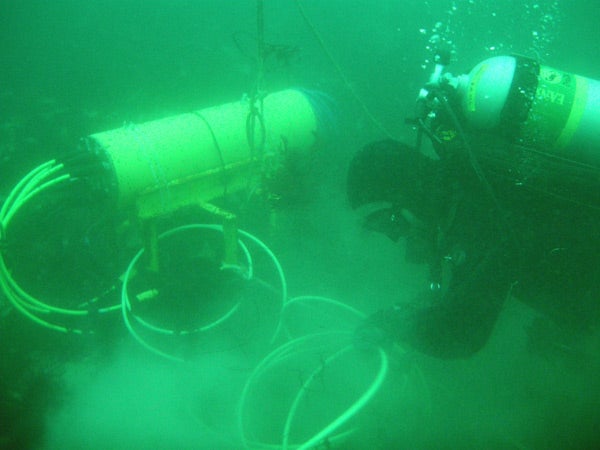|
View video here.
September 27, 2012
Stanford researchers wire kelp forests off California coast
The Kelp Forest Array, located just offshore of Stanford's Hopkins Marine Station, will provide the power and real-time data access scientists need to monitor the effects of climate change on the California coast. By Max McClure

A diver conducts an experiment on the Kelp Forest Array off the coast of Monterey, Calif. (Photo: Environmental Fluid Mechanics Lab / Stanford University)
Pity the marine scientist. In the harsh, difficult-to-reach ocean environment, even a simple monitoring experiment is a leap of faith.
"It's a common experience," said Jeffrey Koseff, director of the Stanford Woods Institute for the Environment. "You place instruments out there, come back several weeks later, and find that they had failed after just three hours."
Many underwater instruments don't have a connection to the surface or land. This means that they run on batteries and store their data underwater – and researchers can't know if they fail until it's too late.
The Kelp Forest Array, or KFA, solves this problem. Intended as a platform for climate change monitoring efforts in California's delicate coastal ecosystems, the array provides data and electric infrastructure to the kelp forests just offshore of Stanford's Hopkins Marine Station in Pacific Grove, Calif. With a broadband cable, the array will allow a wide variety of oceanographic instruments to deliver data to researchers in real-time.
"Instead of bringing the animals or the chemistry into the lab, we have taken the lab out into the field," said Brock Woodson, a Stanford civil and environmental engineering research associate.
Woodson has spearheaded the array project as an early career science fellow at the Center for Ocean Solutions – a collaboration among the Woods Institute and Hopkins Marine Station at Stanford University, the Monterey Bay Aquarium and the Monterey Bay Aquarium Research Institute. The array operates within the Hopkins Marine Station's Marine Life Observatory.
Marine broadband
The Monterey kelp forest is a remarkable ecosystem – a forest of enormous, slender plants, densely populated by a unique and multicolored collection of sea creatures.
"It's not unlike being in a redwood forest onshore," said Woodson.
As climate change affects the Earth's oceans, scientists can only guess at how these quintessentially Californian coastal communities will react. The array's high-resolution look at kelp forest ecosystems is meant to change this.
"The amount of data we're collecting is pretty mind-boggling," Woodson said. The array can generate data at approximately 1 gigabyte an hour – the rough equivalent of half a million pages of text.
A main node, located about 50 feet below the surface of the water, acts as a hub for a suite of scientific instruments scattered throughout Lovers Point Marine Reserve and the Monterey Bay National Marine Sanctuary.
The design represents the third generation of marine cabled systems, including the Naval Postgraduate School's Monterey Inner Shelf Observatory and the University of Hawaii at Manoa's Kilo Nalu Nearshore Reef Observatory, and the first to be placed within a critical coastal habitat.
Underwater redwoods
The array completed its maiden experiment in August. Using an 8-meter tall structure known as the Monterey Observatory Tower Node, or MOTOWN, researchers have taken a look at the fluid mechanics of internal waves – waves that break underwater when cold, deep-ocean water meets the warmer surface water of Monterey Bay.
But the variety of experiments the array can support is broad. "It depends on whatever you want to put on your instrument platform," said Koseff.
The KFA will constantly perform long-term monitoring of climate change variables such as temperature, salinity, current velocity, and pH, oxygen and carbon dioxide levels. An underwater camera may soon provide a live video feed, which will be made available online.
And a new study is currently in preparation: Titled the shallow-water Free Ocean Carbon Enrichment experiment, the project will allow researchers to examine the effects of ocean acidification on organisms without taking them out of their natural habitat.
Koseff, for one, envisions the KFA as not only hosting a variety of experiments but spawning other such observatories. In the future, there could be an "array of arrays" along the central California coast.
"Having one is great," he said. "But having one is not enough."
-30-
|